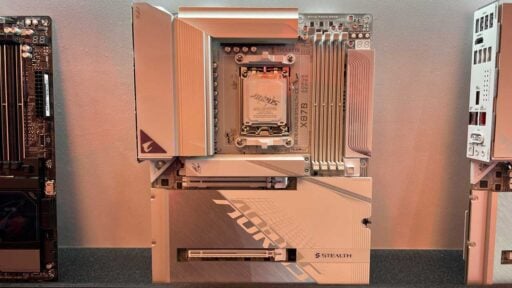In this review, we are taking a closer look at the Swift PG32UCDM. This is a flagship gaming monitor from ASUS ROG, featuring a 32″ 4K UHD QD-OLED panel with a 240 Hz refresh rate. The monitor retails for $1499 USD, or about ₱93,190 PHP locally – shipping and taxes considered.
Disclosure: ASUS sent the ROG Swift PG32UCDM for the purpose of this review. As usual, the brand did not ask me to say anything particular about it.
Table of Contents:
Technical Specifications
Tech specification wise, the PG32UCDM looks impressive with its QD-OLED panel, 240 Hz refresh rate and resolution combined. That’s on top of its rated brightness, contrast ratio, and response time.
| Display | |
|---|---|
| Panel Size | 32 in |
| Panel/Backlight | QD-OLED |
| Surface Treatment | Hard-Gloss |
| Resolution | 3840 x 2160 (16:9) |
| Pixel Density | 137.68 ppi |
| Refresh Rate | 240 Hz |
| Variable Refresh Rate | Adaptive-Sync |
| Brightness | 450 cd/m2 |
| Contrast Ratio | 1,500,000:1 |
| Response Time | 0.03 ms (GtG) |
| Color Coverage | N/A |
| Color Depth | 10-bit |
| Connectivity | |
| Display | 2x HDMI (2.1), DisplayPort (1.4) |
| USB | USB Type-C (DP Alt Mode + PD 90 W), 3x USB Type-A, USB Type-B (Hub) |
| Audio | 3.5 mm (Headphone-out), S/PDIF |
| Ergonomics | |
| VESA Mount | 100 x 100 mm |
| Pivot | -5°/+5° |
| Swivel | -15°/+15° |
| Tilt | -5°/+20° |
| Lift | 0-80 mm |
| Anti-strain | Low Blue Light |
| Dimensions | |
| Length | 718 mm |
| Width | 74 mm |
| Height | 430 mm |
| Weight | 6 kg (w/o stand) |
Packaging and Accessories
The Swift PG32UCDM comes in a huge box, housing its parts and accessories in a molded cardboard packaging. The monitor could be accessed by removing the cardboard section.
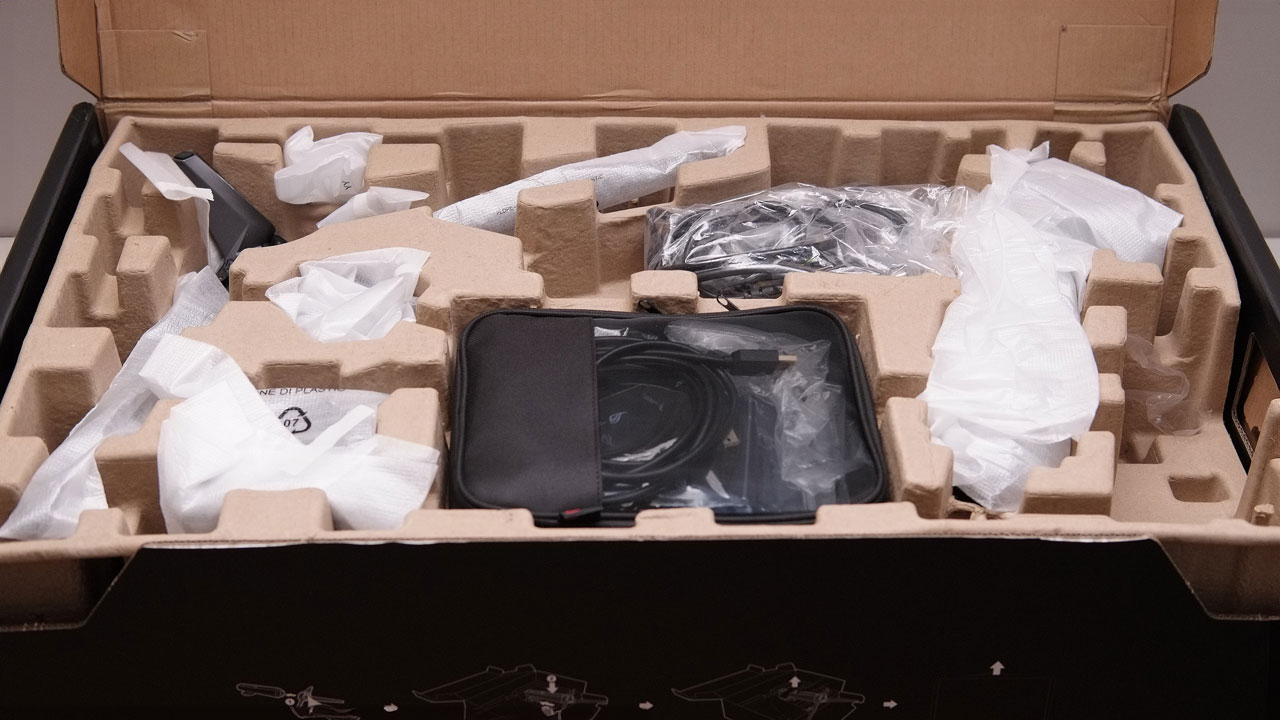
Scope of delivery are as follows:
- ASUS ROG Swift PG32UCDM
- DisplayPort cable
- HDMI Ultra High Speed Cable
- Power adapter
- Power cord
- Quick start guide
- ROG pouch
- ROG sticker
- USB 3.2 cable
- USB-C cable
- VESA mount kit
- Warranty Card
It is a rite of passage to receive an array of bundled accessories with any ROG products. You even get a pouch to store the cables along with the paper work.
Design, Build and Connectivity
The PG32UCDM follows the design elements of the ROG Swift monitor line-up, featuring the same tripod base design but with a few improvements. That includes the shorter rear pod for better desk clearance, along with the chin-mounted OSD joystick and buttons.
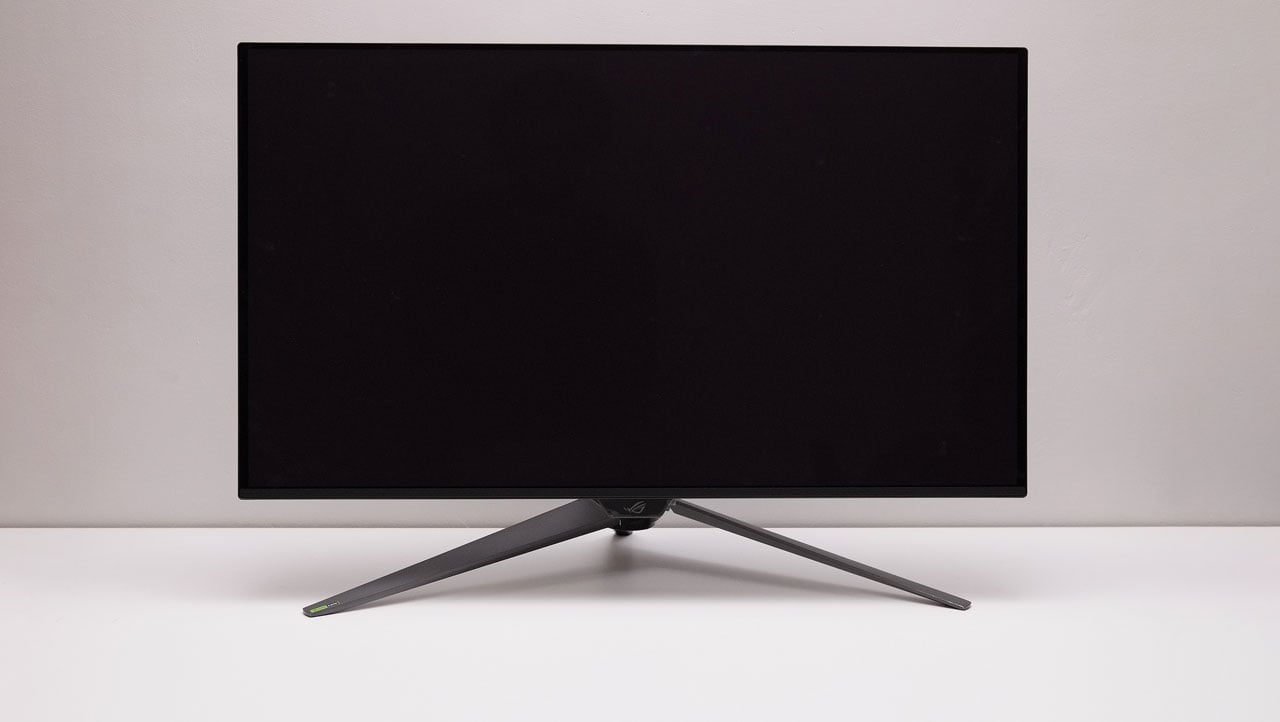
The rear-end looks similar to the PG27AQDM – which is yet another OLED gaming monitor. This design allows the monitor to look thin on certain angles. Functionally, this serves as the cover for the controller board and the passive heatsink for the QD-OLED panel. I was told this also comes with a graphene sheet as a thermal interface material.
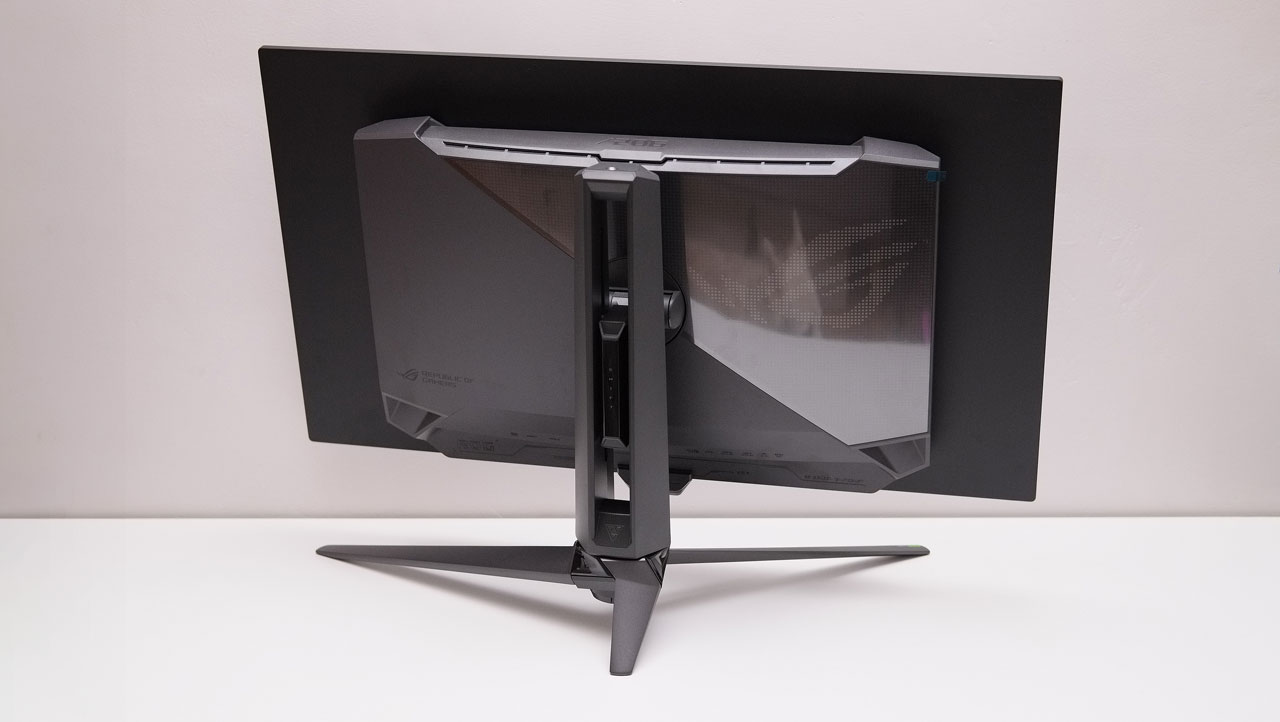
The OSD navigation is again, chin-mounted, simplifying access to the PG32UCDM’s settings. Regarding inputs and outputs, the monitor boasts DisplayPort 1.4 with DSC, dual HDMI 2.1 ports, a Type-B port to connect Type-A ports for KVM functionality, a headphone jack, an S/PDIF out, and a PD 90 W capable USB Type-C/DP Alt port. For those with an Intel Thunderbolt-enabled notebook, the PG32UCDM serves as a single-cable solution for both power and display extension.
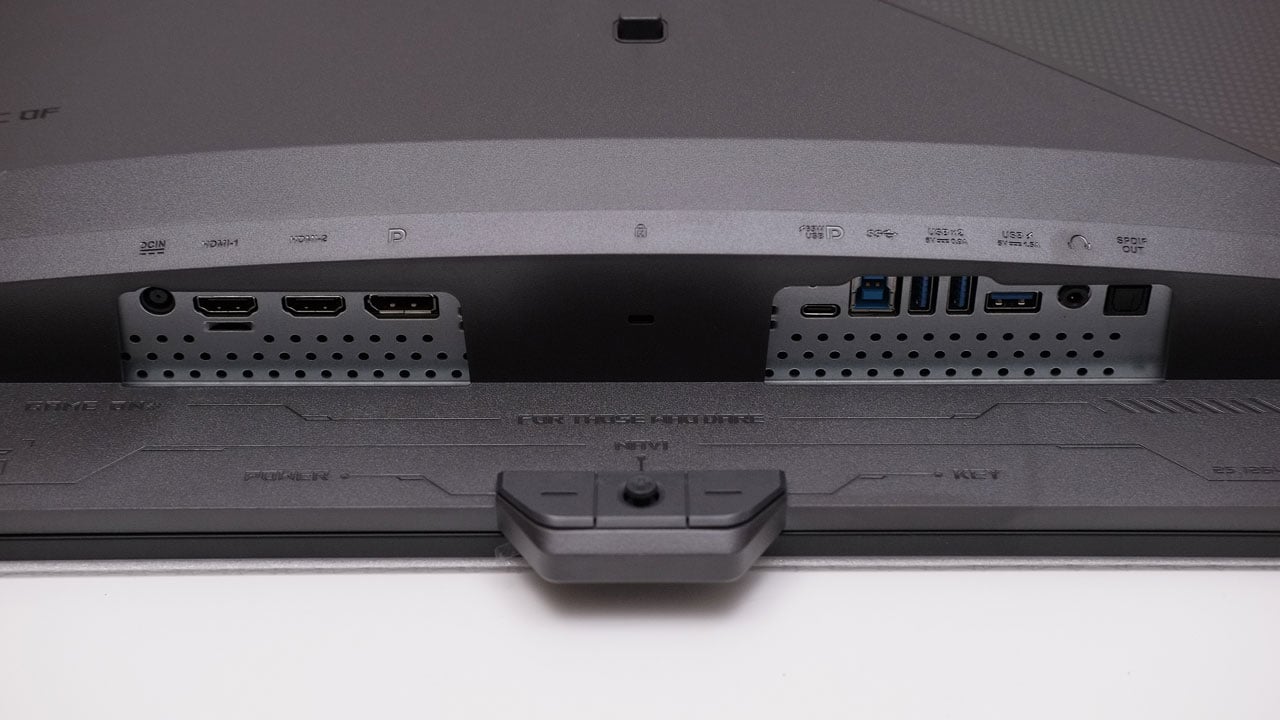
The build quality, design, and connectivity options are excellent. Given its price of $1499 USD, such features are expected. However, it would be beneficial if it included a built-in speaker or perhaps a smaller power adapter, as the current one is quite bulky.
Ergonomics
The PG32UCDM comes with a 32 inch panel featuring a native resolution of 3840 x 2160, translating to a pixel density of 137.68 ppi. That said, I find the resolution and panel size combination excellent, especially for productivity where you could open applications side by side without the obvious restriction of smaller screens and resolutions. However, since the PG32UCDM rocks a glossy panel, you have to make sure that it is not placed against a direct light source. With its size, you also have to make sure that your desk is at least 60 cm deep. This is to ensure that you have enough space for your gears, plus enough space between yourself and the monitor.
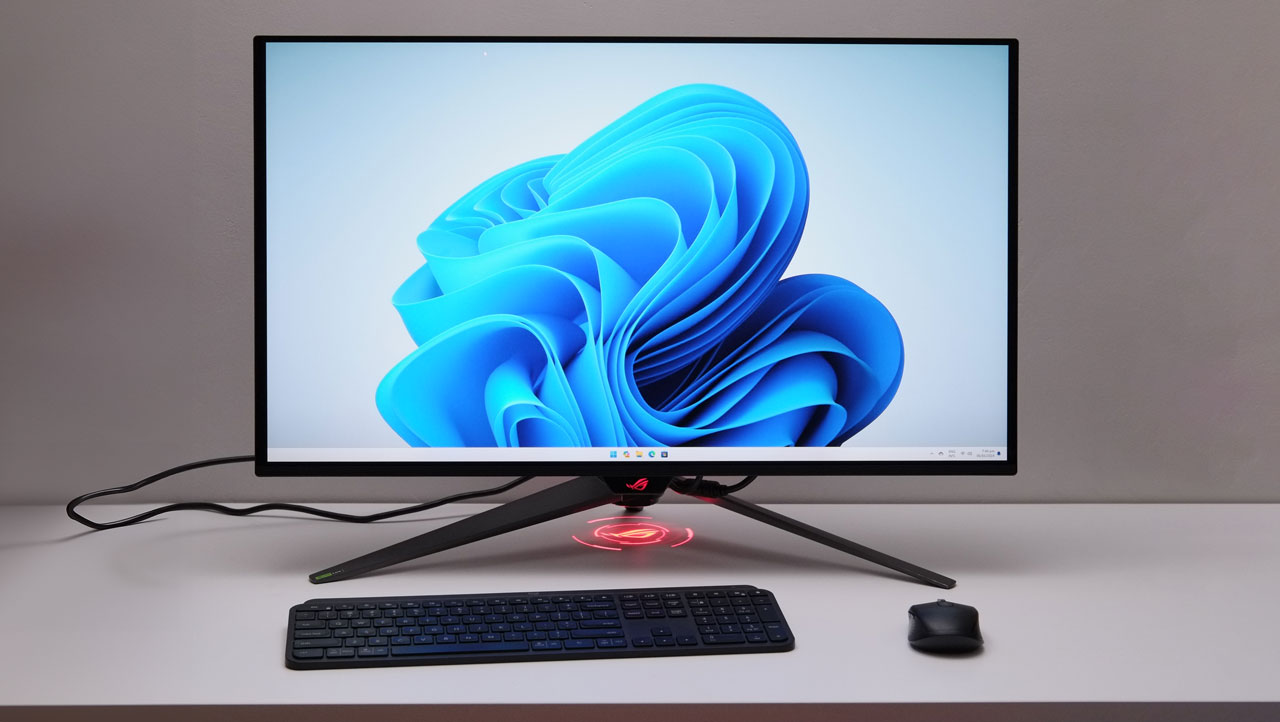
For those with a more limited desk space or requires to mount their monitor vertically, a third-party monitor mount is advisable. ASUS provides a VESA adapter with the PG32UCDM -though it would also be great if they included the ROG Monitor Desk Mount Kit, which allows the stand to be converted into a mount.
OSD Menu
The PG32UCDM’s On-Screen Display features familiar settings, as well as some unique to its OLED nature. Among the eight main menus, Gaming is is one of the most important ones. This menu allows you to select the presets or profiles via the GameVisual sub-menu.
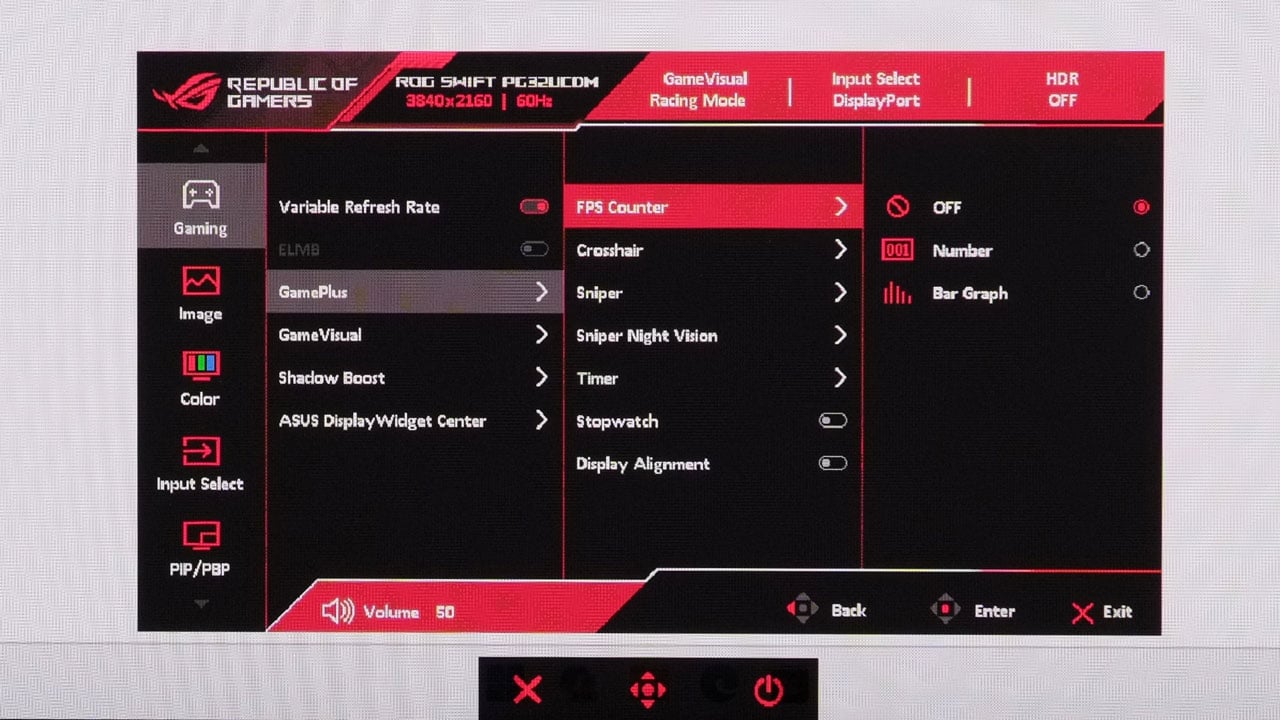
The Image menu allows you to adjust the brightness, contrast, and other basic settings. However, the availability of these options depends on the selected profile. For an instance, some settings may be inaccessible when HDR mode or sRGB mode is enabled.
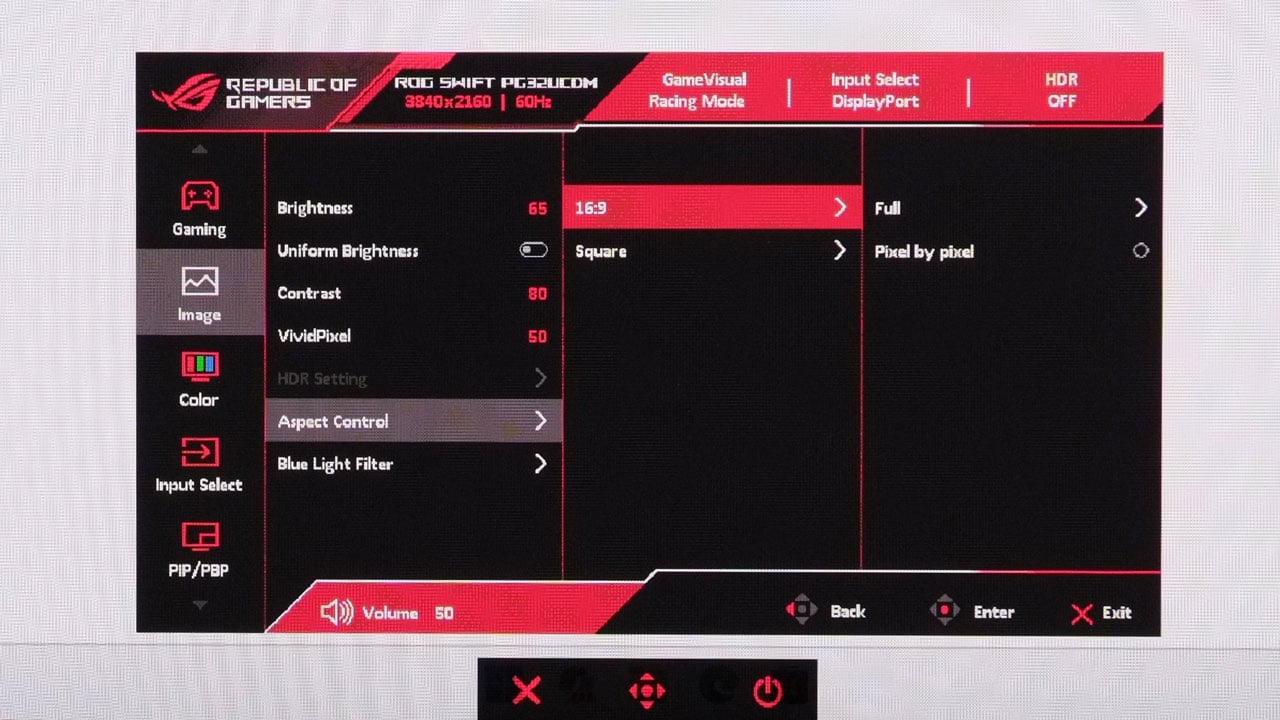
The Color menu is yet another vital feature in the PG32UCDM’s OSD, offering options like Display Color Space, Color Temperature, Saturation, and Six-axis Saturation, in addition to the fundamental Gamma level adjustments. Some of these settings are only found on pro-level display panels.
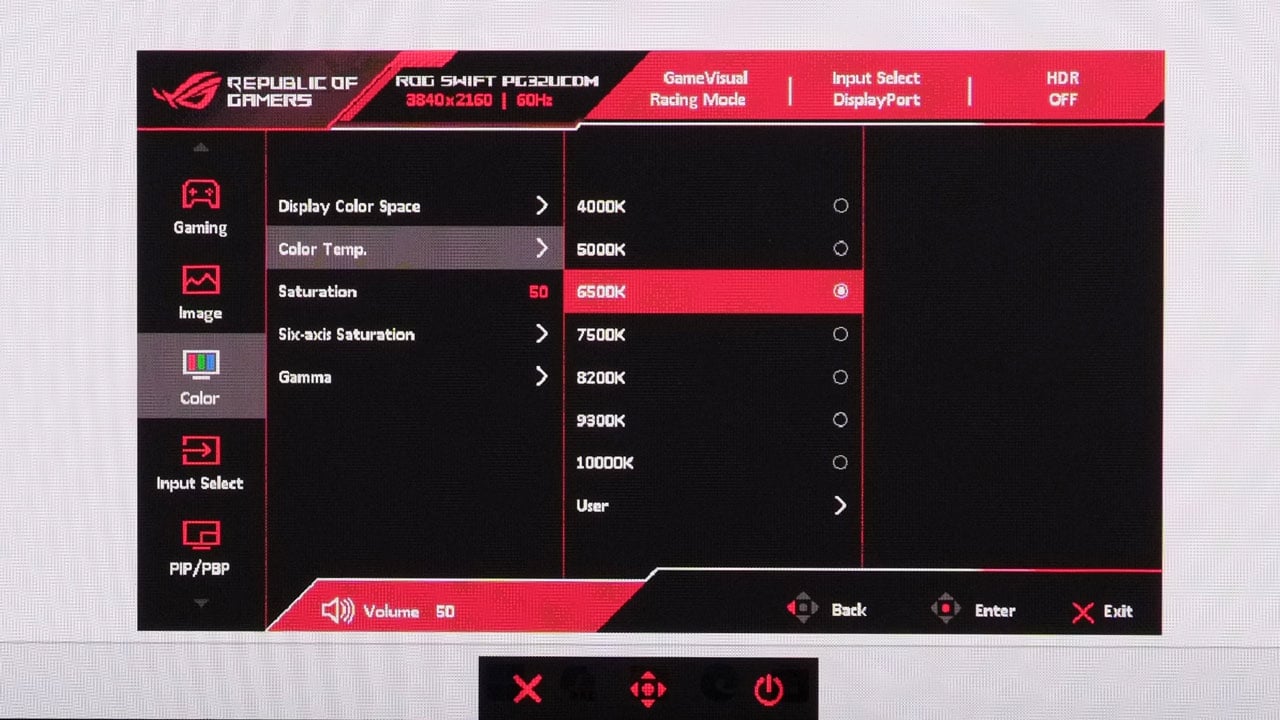
System setup is the location for most firmware-level settings. For instance, the KVM can be configured here to automatically detect its connection type, – or have it set manually.
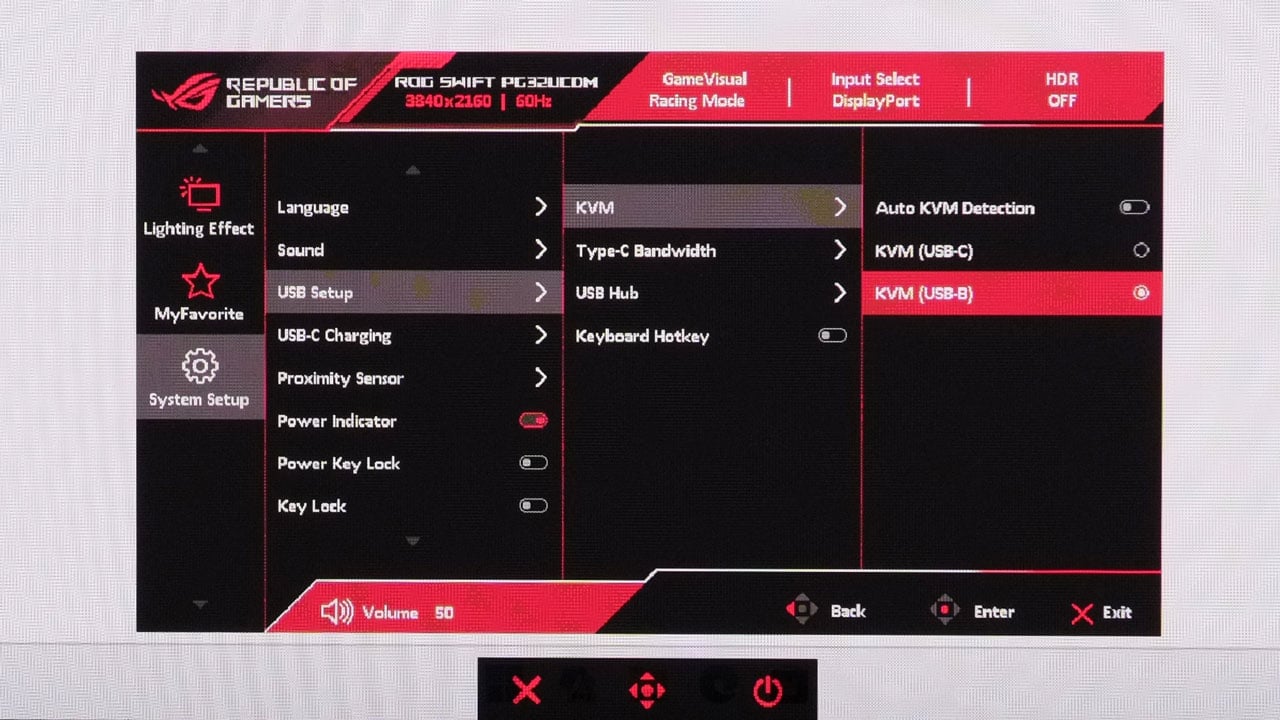
The OLED protection settings can be found in the same menu. New to me is the Screen Saver option, which enables the display to automatically dim after a few minutes of inactivity.
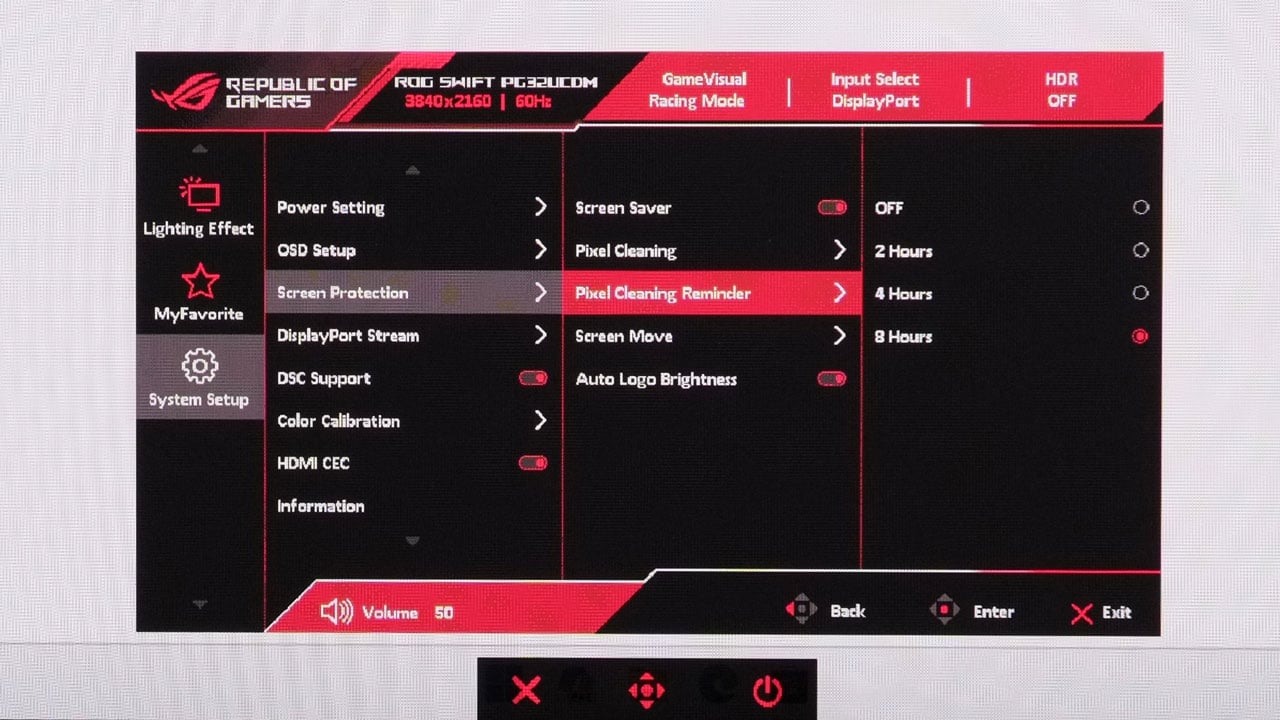
Many of the features available in the OSD can also be accessed through the ASUS DisplayWidget, a complementary software that you can download if you prefer using an application to suit your style better.
OSD Presets
The PG32UCDM comes with 9 presets, 10 if we also consider the HDR mode. I’ve made a calibrated profile with the User settings, but I just cannot beat the sRGB Cal mode – an out of the box profile made by ASUS from the factory using a Kodak spectrometer. My attempts have come close, but my colorimeter lacks the precision needed to calibrate QD-OLED panels accurately.
| Spyder5 ELITE | OSD Settings | ||||
|---|---|---|---|---|
| Settings | Brightness (cd/m²) | Black Level (%) | Contrast (:) | White Point (K) |
| Scenery | 240.3 | 0.00 | 240330:1 | 6300 |
| Racing | 148.0 | 0.00 | 148010:1 | 6600 |
| Cinema | 175.7 | 0.00 | 175660:1 | 7700 |
| RTS/RPG | 203.1 | 0.00 | 203110:1 | 6400 |
| FPS | 219.1 | 0.00 | 219100:1 | 6600 |
| sRGB Cal | 91.9 | 0.00 | 91880:1 | 6600 |
| MOBA | 203.0 | 0.00 | 203040:1 | 6600 |
| Night Vision | 18.6 | 0.00 | 18560:1 | 6600 |
| User | 181.9 | 0.00 | 181910:1 | 6600 |
OSD settings are as follows:
- Preset = sRGB Cal
- Brightness = 53 (120 cd/m²)
- Contrast = N/A
- Color Temperature = N/A
- Gamma = N/A
- Color Space = N/A
Gamut
Coverage is extremely good across the available range of color spaces tested – NTSC included.
| Spyder5 ELITE | Gamut, Percent (%) | ||||
|---|---|---|---|---|
| Color Space | sRGB | AdobeRGB | DCI-P3 | NTSC |
| Measured | 100 | 96 | 100 | 94 |
Tone Response
Gamma level is on the spot at least for the first three presets.
| Spyder5 ELITE | Tone Response, Gamma (γ) | |||||
|---|---|---|---|---|---|
| Target | 1.8 | 2.0 | 2.2 | 2.4 | 2.6 |
| Measured | 1.8 | 2.0 | 2.2 | 2.3 | 2.4 |
Brightness and Contrast
The SDR brightness peaks at 279.5 cd/m², which is significantly lower than the expected rating. Nonetheless, this is typically not a concern in SDR mode – unless placed in an overly bright area. Given its glossy panel surface treatment, it’s unlikely that anyone would consider using the PG32UCDM in such conditions.
| Spyder5 ELITE | Brightness and Contrast (SDR) | ||||
|---|---|---|---|---|
| Settings | Brightness (cd/m²) | Black Level (%) | Contrast (:) | White Point (K) |
| 0% | 3.0 | 0.00 | 3050:1 | 6900 |
| 25% | 31.1 | 0.00 | 31070:1 | 6600 |
| 50% | 93.4 | 0.00 | 93420:1 | 6600 |
| 75% | 155.0 | 0.00 | 155030:1 | 6700 |
| 100% | 279.5 | 0.00 | 279470:1 | 6400 |
HDR mode shows that it could reach 652.32 cd/m² which is now way higher compared to the specifications. While the PG32UCDM is rated for DisplayHDR 400 (400 nits @ 8% center patch), it may be fitting to the DisplayHDR True Black 400 rating due to its local-dimming support, which is inherent to its QD-OLED panel.
Screen Uniformity
Color uniformity is excellent for its class, reaching an average Delta-E less than that of 2.
| Spyder5 ELITE | Color Uniformity, Delta-E (ΔE) | ||
|---|---|---|
| 0.4 | 1.5 | 1.0 |
| 1.2 | 1.3 | 0.9 |
| 0.8 | 0.5 | 0.0 |
Luminance hotspots are also excellent or rather almost non-existent. I could tell ASUS worked its QA department’s butts with regards to the panel selection process.
| Spyder5 ELITE | Luminance Uniformity, Percent (%) | ||
|---|---|---|
| 2 | 0 | 2 |
| 2 | 1 | 2 |
| 2 | 2 | 2 |
Color Accuracy
Color accuracy is great, resulting at an average of 1.51 ΔE – with the exception of cyan. With a larger set of colors to test (48), this goes even lower at 1.33 ΔE.
| Spyder5 ELITE | Color Accuracy, Delta-E (ΔE) | ||
|---|---|---|
| Patch ID | sRGB | Measured |
| 1E | 249, 242, 238 | 0.28 |
| 2E | 202, 198, 195 | 0.09 |
| 3E | 161, 154, 157 | 0.48 |
| 4E | 122, 118, 116 | 1.15 |
| 5E | 80, 80, 78 | 1.48 |
| 6E | 43, 41, 43 | 2.37 |
| 1F | 0, 127, 159 | 6.40 |
| 2F | 192, 75, 145 | 0.73 |
| 3F | 245, 205, 0 | 0.28 |
| 4F | 186, 26, 51 | 1.43 |
| 5F | 57, 146, 64 | 1.99 |
| 6F | 25, 55, 135 | 1.41 |
| Minimum | 0.09 | |
| Maximum | 6.40 | |
| Average | 1.51 | |
Response Time
The PG32UCDM currently boasts the best response time I’ve observed in any gaming monitor, averaging an impressive 0.8 ms. With the variable refresh rate enabled, the response time slightly increases to 0.91 ms, which is still impressive.
| OSRTT | Perceived Response Time, Millisecond (ms) | ||||||
|---|---|---|---|---|---|---|
| 0 | 51 | 102 | 153 | 204 | 255 | |
| 0 | 0.5 | 0.3 | 0.4 | 0.4 | 0.4 | |
| 51 | 0.7 | 0.6 | 0.8 | 0.9 | 0.9 | |
| 102 | 0.8 | 0.6 | 0.8 | 1.2 | 1.2 | |
| 153 | 0.9 | 0.8 | 0.7 | 0.8 | 0.8 | |
| 204 | 1.1 | 0.8 | 1.2 | 0.8 | 0.7 | |
| 255 | 1.2 | 0.9 | 1.2 | 0.8 | 0.7 | |
Now RGB overshoot has an average error of 2.03, with a value above 10 RGB at just under 3.33%. That is practically zero overshoot.
| OSRTT | RGB Overshoot, Error | ||||||
|---|---|---|---|---|---|---|
| 0 | 51 | 102 | 153 | 204 | 255 | |
| 0 | 3 | 7 | 5 | 4 | 4 | |
| 51 | 0 | 6 | 4 | 3 | 2 | |
| 102 | 0 | 11 | 0 | 0 | 0 | |
| 153 | 0 | 5 | 0 | 0 | 0 | |
| 204 | 0 | 3 | 0 | 0 | 1 | |
| 255 | 0 | 3 | 0 | 0 | 0 | |
Input Lag
Regarding input lag, the PG32UCDM’s average latency is approximately 2.56 ms, with the lowest recorded at 0.17 ms.
Power
At 120 cd/m², power consumption was measured at approximately 53.21 W. The increase in power consumption is consistent from 0% to 100% brightness level, which is efficient even with power saving modes disabled. Given that power consumption will be higher with HDR mode, the inclusion of a substantial 280 W power brick with this monitor seems appropriate.
Final Thoughts
The ASUS ROG Swift PG32UCDM is a top-tier gaming monitor that boasts a 32-inch 4K UHD QD-OLED panel with a swift 240Hz refresh rate. Packed with high-end features and superior build quality, it continues ASUS ROG’s legacy of including a generous array of accessories with their products.
The PG32UCDM boasts the recognizable ROG Swift design, enhanced with a more compact stand to improve desk space. It offers a range of connectivity options such as DisplayPort 1.4 with DSC, HDMI 2.1 ports, and a USB Type-C/DP Alt port, accommodating a variety of devices and configurations.
The on-screen display offers an extensive array of settings, including gaming presets, image adjustments, color configurations, and system settings. It would be convenient if ASUS allocated a dedicated main menu for OLED-related settings to simplify the periodic maintenance of the panel.
The 32″ panel with 4K resolution offers excellent productivity potential, though requiring a deep desk space – even with the short stand considered. A VESA mounting adapter is also provided for alternative setup or requirements. For the price, they should’ve included the ROG Monitor Desk Mount Kit to transform the stand into a desk mount. C’mon ASUS, if I’m paying almost two grands – at least locally, please consider it.
Now the PG32UCDM offers excellent out of the box factory calibrated presets with accurate color reproduction across various color spaces. Gamma levels, brightness, and contrast also perform well, with HDR mode exceeding my expectations.
Color uniformity and accuracy are excellent, with minimal luminance hotspots and an average Delta-E of 1.51. Response time is impressive at 0.8 ms, with minimal RGB overshoot to boot. Input lag averages around 2.56 ms, with minimal latency ensuring smooth gaming performance. This QD-OLED display is fantastic for gaming and pretty much any content.
Power consumption remains efficient, with efficient energy usage across brightness levels. While bulky, the inclusion of the 280 W power brick accommodates the monitor’s demands, especially with HDR and the 90 W PD considered.
The ASUS ROG Swift PG32UCDM stands out with its high-end features, superior performance, and build quality, justifying its position as a top-tier product with a price to match.
ASUS ROG Swift PG32UCDM Monitor $1,499 USD

Product Name: ROG Swift PG32UCDM
Product Description: The ASUS ROG Swift OLED PG32UCDM is a 32-inch 4K QD-OLED panel, perfectly capable of delivering astounding visuals at a buttery-smooth 240 Hz.
Brand: ASUS
Summary
The ASUS ROG Swift PG32UCDM ranks among the top gaming monitors that your money could possibly buy right now. It is that good – even with its local pricing considered.
Pros
- Build quality and design
- Connectivity options
- OSD settings and navigation
- Low input lag
- Fast response time
- Color accuracy and coverage
- Brightness and contrast
- Usable HDR mode
- Screen uniformity
- Ergonomics
Cons
- Price
- Massive power brick



